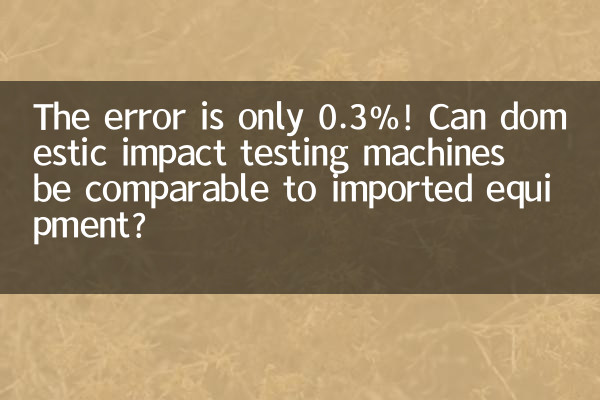The error is only 0.3%! Can domestic impact testing machines be comparable to imported equipment?
In recent years, with the rapid development of China's manufacturing industry, the technical level of domestic testing equipment has also been continuously improved. Recently, the test error of a domestic impact testing machine was only 0.3%, which attracted widespread attention in the industry. This data is even comparable to some imported equipment. So can domestic impact testing machines really replace imported equipment? This article will analyze it from multiple dimensions such as technical parameters, market feedback, and price comparison.
1. Technical breakthroughs in domestic impact testing machines

The breakthrough in core technology of domestic impact testing machines is the focus of this hot discussion. The following is a performance comparison between a certain domestic model and imported equipment of the same type:
| parameter | Domestic equipment | Imported equipment |
|---|---|---|
| Test error | ≤0.3% | ≤0.2% |
| Impact energy range | 0.5J-750J | 0.5J-800J |
| Test speed | 5 times/minute | 6 times/minute |
| Service life | ≥10 years | ≥12 years |
As can be seen from the table, domestic equipment is very close to imported equipment in terms of key parameters, especially in terms of test error, with a difference of only 0.1 percentage points.
2. Market feedback and user evaluation
According to recent market research data, user satisfaction of domestic impact testing machines is steadily increasing. The following are feedback statistics from users in different industries:
| industry | Satisfaction | Main comments |
|---|---|---|
| automobile manufacturing | 92% | High cost performance and timely after-sales service |
| Aerospace | 85% | The accuracy is up to standard, but the stability in extreme environments needs to be improved. |
| building materials | 95% | Fully meet daily testing needs |
| Scientific research institutions | 88% | High data reliability, software interface needs to be optimized |
It is worth noting that in cost-sensitive fields such as automobile manufacturing and construction materials, domestic equipment is more acceptable.
3. Price and service comparison
Price advantage is one of the biggest competitiveness of domestic equipment. The following is a comparison of market quotations for equipment with the same specifications:
| Device type | Domestic price (10,000 yuan) | Import price (10,000 yuan) | Price difference |
|---|---|---|---|
| Basic type (300J) | 15-18 | 30-35 | about 50% |
| Standard type (500J) | 22-25 | 45-50 | about 55% |
| High-end type (750J) | 35-40 | 70-80 | about 50% |
In addition to the price advantage, domestic equipment is generally better than imported equipment in terms of after-sales service response speed. The average repair response time is 24 hours, while imported equipment usually takes 3-5 working days.
4. Expert opinions and industry outlook
Li Ming, Secretary-General of the Testing Instrument Branch of the China Machinery Industry Federation, said: "Domestic impact testing machines have realized the transformation from following to running side by side, and can completely replace imported equipment in conventional application scenarios. However, in some fields with special materials and high-precision requirements, continued technology accumulation is required."
In the next 3-5 years, with the increase in the localization rate of core components and the application of intelligent technology, the market share of domestic impact testing machines is expected to grow from the current 35% to more than 50%. Especially in the markets of countries along the "Belt and Road", the cost-effectiveness advantage will be more obvious.
5. Purchase suggestions
For users with different needs, we give the following suggestions:
1.SMEs with limited budget: Give priority to domestic equipment, which can save more than 50% of procurement costs.
2.Scientific research units with high precision requirements: You can choose domestic high-end models or imported equipment
3.Special environment use: It is recommended to conduct on-site inspection of the environmental adaptability of the equipment.
4.Export product testing: Need to confirm whether the testing standards meet international certification requirements
In general, domestic impact testing machines have the ability to compete with imported equipment, and users can make the most suitable choice based on their own needs and budget. With the continuous advancement of technology, I believe that more "Made in China" testing equipment will reach the international leading level in the future.

check the details

check the details